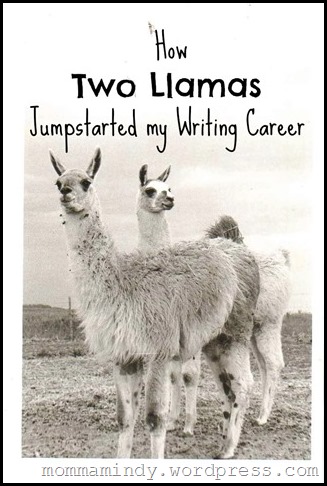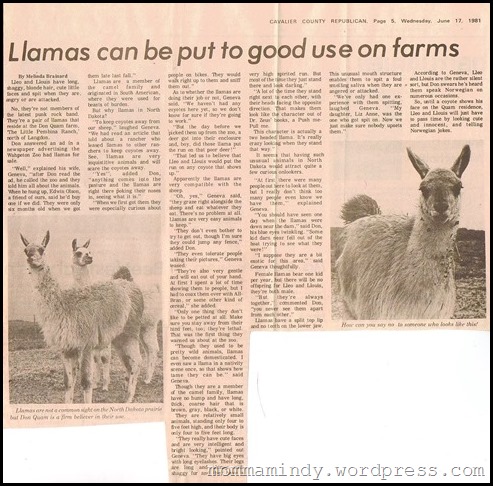In 1981, big things were happening in the world. Ronald Reagan was inaugurated as president, the Iranian hostages were finally released, and Judge Sandra Day O’Connor became the first woman on the US Supreme Court.
During the tumultuous hostage crisis our nation was glued to their TVs for days, watching world events unfold.
That summer I was hired by the local newspaper, the Cavalier County Republican, as a reporter. A 16-year-old kid in braces, I was thrilled to have a part in providing my journalistic slant on the changing world.
Except the news in Langdon, North Dakota, a small town you skip through on the way to Canada, wasn’t nearly as exciting. For my first interview my editor had the scoop of the century; a local farmer had purchased two exotic animals.
The farmer was my next door neighbor, Don Quam, a man who could tell tall tales bigger than Paul Bunyan’s and tell you true tales you wished were tall tales, with a twinkle in his eye and a smile on his tan, creased face. No, it isn’t a cliché, his eyes did twinkle. Geneva was his perfect match, a spunky blonde who kept him in line.
Two llamas, two friendly neighbors, how hard could that assignment be? Except I’d never written a newspaper article before, not even in high school English class. I hadn’t used a 35mm camera in a few years. A pad of lined yellow paper, a pen, and a Canon camera were thrust into my hands.
While interviewing Don and Geneva I scribbled frantically as they joked and spoke wise words worth quoting about their llamas, Lleo and Llouis. Because I didn’t have a telephoto lens, I cautiously entered the pasture for close-up pictures. I’d learned the llamas were walking on lethal weapons and could spit.
My story was typed and submitted without any feedback from my editor. I still wasn’t sure if it qualified as an article, but it was printed.
All errors aren’t necessarily mine, cringe, because the typesetter, who got an A in high school typing but not in English, often felt the need to “correct” my work.
(click on pic to enlarge and read or read full text below)
A few days later my jubilant editor waved a Grand Forks Herald in my face and pointed to a llama story.
He bragged that my first article was picked up by a big-city daily newspaper and assured my career was off to a great start, thanks to Lleo and Llouis.
Thirty-three years later, the reporter in me wants to write a follow-up to my exciting career launch. Would Liz Anne remember the llama spit? Would she remember me?
Is it really suitable to call someone thirty-three years later and ask, “Hey, do you remember being spit on by a llama?”
I know you’re wondering, too, right? Do ya’ double-dog dare me?
Stay tuned. Monday’s follow-up is surely to be picked up by the Herald.
Two llamas jumpstarted a writing career.
~~~~~~~~~~~~~~~~~~~~
Llamas can be put to good use on farms
by Melinda Brainard
CAVALIER COUNTY REPUBLICAN, Page 5, Wednesday, June 17, 1981
Lleo and Llouis have long, shaggy, blonde hair, cute little faces and spit when they are angry or are attacked.
No, they’re not members of the latest punk rock band. They’re a pair of llamas that reside at the Don Quam farm, The Little Pembina Ranch, north of Langdon.
Don answered an ad in the newspaper advertising the Wahpeton Zoo had llamas for sale.
“Well,” explained his wife, Geneva, “after Don read the ad, he called the zoo and they told him all about the animals. When he hung up, Edwin Olson, a friend of ours, said he’d buy one if we did. They were only six months old when we got them late last fall.”
Llamas are a member of the camel family and originated in South America, where they were used for beasts of burden.
But why llamas in North Dakota?
“To keep coyotes away from our sheep,” laughed Geneva. “We had read an article that told about a rancher who leased llamas to other ranchers to keep coyotes away. See, llamas are very inquisitive animals and will scare the coyotes away.
“Yes,” added Don, “anything comes into the pasture and the llamas are right there poking their noses in, seeing what it is.”
“When we first got them they were especially curious about people on bikes. They would walk right up to them and sniff them out.”
As to whether the llamas are doing their job or not, Geneva said, “We haven’t had any coyotes here yet, so we don’t know for sure if they’re going to work. But the day before we picked them up from the zoo, a deer got into their enclosure and boy, did those llamas put the run on that poor deer! That led us to believe that Lleo and Llouis would put the run on any coyote that shows up.”
Apparently the llamas are very compatible with the sheep.
“Oh yes,” Geneva said, “they graze right alongside the sheep and eat whatever they eat. There’s no problem at all. llamas are very easy animals to keep.”
“They don’t even bother to try to get out, though I’m sure they could jump any fence,” added Don.
“They even tolerate people taking their pictures,” Geneva teased.
“They’re also very gentle and will eat out of your hand. At first I spent a lot of time showing them to people, but I had to coax them over with All-Bran, or some other kind of cereal,” she added.
“Only one thing, they don’t like to be petted at all. make sure you stay away from their hind feet, too; they’re lethal. that was the first thing they warned us about at the zoo.”
“Though they used to be pretty wild animals, llamas can become domesticated. I even saw a llama in a nativity scene once, so that shows how tame they can be,” said Geneva.
Though they are a member of the camel family, llamas have no hump and have long, thick, course hair that is brown, gray, black, or white.
They are relatively small animals, standing only four to five feet high, and their body is only four to five feet long.
“They really have cute faces and are very intelligent and bright looking,” pointed out Geneva. “They have bi eyes with long eyelashes. Their legs are long and skinny with shaggy fur and they have a very high spirited run. But most of the time they just stand there and look darling.”
“A lot of the time they stand right next to each other, with their heads facing the opposite direction. That makes them look like the character out of Dr. Zeus’ books, a Push me-Pull me. This character is actually a two headed llama. It’s really crazy looking when they stand that way.”
It seems that having such unusual animals in North Dakota would attract quite a few curious onlookers.
“At first there were many people out here to look at them, but I really don’t think too many people even know we have them,” explained Geneva.
“You should have seen one day when the llamas were down near the dam,” said Don, his blue eyes twinkling. “Some kid darn near fell out of the boat trying to see what they were!”
“I suppose they are a bit exotic for this area,” said Geneva thoughtfully.
Female llamas bear one kid per year, but there will be no offspring for Lleo and Llouis, they’re both male.
“But they’re always together,” commented Don, “you never see them apart from each other.”
Llamas have a split top lip and no teeth on their lower jaw. This unusual mouth structure enables them to spit a foul smelling saliva when they are angered or attacked.
“We’ve only had one experience with them spitting, laughed Geneva. “My daughter, Liz Anne, was the one who got spit on. Now we just make sure nobody upsets them.”
According to Geneva, Lleo and Llouis are the rather silent sort, but Don swears he’s heart them speak Norwegian on numerous occasions.
So, until a coyote shows his face on the Quam residence, Lleo and Llouis will just have to pass time by looking cute and innocent, and telling Norwegian jokes.
Click on photo to read Part Two:







I always wanted Alpacas so I really enjoyed this post!! Wow, Mindy you were famous!!
As famous as you can be in a small town with less than 2,000 and most of them don’t read the newspaper! 🙂 Thanks for stopping by!
That typesetter certainly was a creative type! 🙂
Not kidding, Jayla is wearing a llama shirt today. I showed her your photo and she grinned. 🙂
Oh, that is SO cute! You should post a picture on my FB author page underneath the post. That would be adorbs. Miss your little girls so much.
Oh, and you, too. 🙂